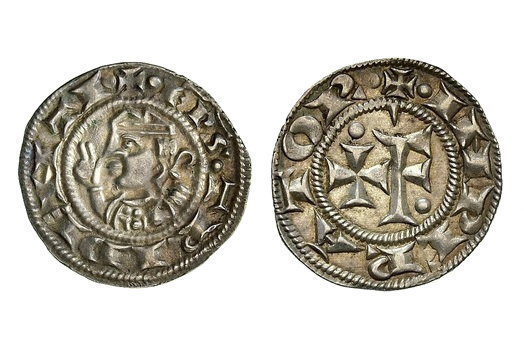
about ancient nomos
Ancient Nomos Art is a museum of galleries exhibiting ancient coins and ancient mint maps. The coin gallery displays the diverse art and history of hand-crafted ancient Greek, Roman, Byzantine, Persian and Medieval coinage. The ancient mints mapping gallery features Greek, Roman, Byzantine, Asia Minor and Medieval mint city regions and territories. Visitor's are welcome to explore, study and enjoy Ancient Nomos Art.

Medieval, Trento – 1255 AD
Trento Grosso
From Ancient Galleries

Obverse: •+•EPS•TRIDENTI, Bust of bishop left, raising hand in benediction and wearing miter.
Reverse: •+•INPERATOR, Large F with pellet, spike above; cross pattée to left with pellet above.
LEGEND
Obv: • + • EPS • TRIDENTI, Bust of bishop left, raising hand in benediction and wearing miter. Rev: • + • INPERATOR, Large F with pellet, spike above; cross pattée to left with pellet above.
Originally, ancient Trento was a Celtic village, but was conquered by the Romans in the 1st century BC, after clashes with the Rhaetian tribes. The Romans gave their Trento settlement the name Tridentum and is a tribute to the Roman god Neptune (Tri Dentum, meaning ‘Three Teeth’) because of the three hills that surround the city. After the fall of the Western Roman Empire, the independent bishopric of Trento was conquered by Ostrogoths, Byzantines, Lombards and Franks, finally becoming part of the Holy Roman Empire. In 1027 AD, Emperor Conrad II created the Prince-Bishops of Trento, who wielded both temporal and religious powers. The obverse depicts the Egno von Eppan (died 25 May 1273 AD), bishop of Brixen from 1240 to 1250 AD and then bishop of Trento until his death. Egno belonged to the family of the counts of Eppan. He became a canon of the cathedral of Trento as an acolyte in 1232 and became a subdeacon in 1234. After the death of Bishop Henry, 18 Nov. 1239 AD, Egno had been elected to succeed him. He was probably chosen by the canons in the hope that his family might help the church resists the counts of Andechs, Gorizia and Tyrol. He received the regalia from King Conrad IV in Nördlingen on 20 May 1240 AD. At Nördlingen, Conrad granted Egno a privilege stating that nobody could cross the duchy of Brixen without the permission of either the emperor, the king or the bishop. At the same time, Egno entered into a business deal with Conrad’s important advisor, Conrad of Winterstetten. Thus, during the papal war against the Hohenstaufen Emperor Frederick II, which began in 1239, Egno wisely supported the emperor. A very rare medieval Trento grosso emission from this tiny region of far northern Italy, clearly citing the Holy Roman Emperor, was executed in absolutely beautiful style and a virtually fleur de coin of Trento.
DOCUMENTATION
Value: Grosso of 20 denari. Metal: AR Silver. Weight: 1.60 grams. Mint: Republic of Trento under Egnone d’Appiano Vescovo. Date: circa 1235-1255 AD.
Attribution: Rizzoli Pigozzo T44; CNI VI 6; Biaggi, Monete e Zecche Medievali Italiane, 2691; MIR 242.1.
Legend, Documentation and Attribution
